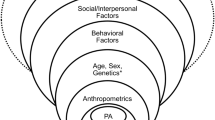Abstract
Introduction
It is still uncertain if having at least moderate physical fitness is a necessary and sufficient condition for lowering the risk of death. The aforementioned statement constituted the basis for undertaking the study concerning the effect of particular health-related behaviours on the likelihood of survival in subjects with a moderate and high physical fitness.
Materials and Methods
The study sample, i.e. 204 men aged 30–59 years living in Łódź, Poland, was selected within the CINDI WHO Programme and examined over the years 1980–1990 and 2003–2004. In each subject approximate values of one week energy expenditures associated with performing physical exercise of at least moderate intensity (> 1000 kcal/week) were estimated. Physical efficiency in the study group was evaluated basing on the results of the submaximal effort test. Information about selected socio-demographic characteristics, consumption of alcohol, cigarette smoking and diet was gathered. The vital status of the examined sample was checked in 2009. The Cox proportional hazards regression model was used to identify factors which influence the survival of examined population.
Results
The probability of death was more than fourfold higher in the case of individuals who eat “beef or pork meat”, as compared to those who consumed these products rarely or never. On the other hand, the subjects who declared regular consumption of yellow cheese had nearly fourfold lower death probability. Current smoking was found to be a significant negative risk factor while moderate consumption of beer a protective one. The level of physical fitness (VO2max) did not significantly influence mortality.
Conclusions
The results of the performed analyses indicate negative effect associated with consumption of beef/pork meat and smoking. Furthermore, the data pertaining to the consumption of yellow cheese as a potent protective factor for men’s health requires further verification. The possibility that it is some lifestyle proxy rather than a causal factor cannot be excluded.
Similar content being viewed by others
References
Shiroma EJi I-Min Lee. Physical activity and cardiovascular health. Lessons learned from epidemiological studies across age, gender, and race/ethnicity. Circulation. 2010;122:743–752, http://dx.doi.org/10.1161/CIRCULATIONAHA.109.914721.
Mathieu RA 4th, Powell-Wiley TM, Ayers CR, McGuire DK, Khera A, Das SR, et al. Physical activity participation, health perceptions, and cardiovascular disease mortality in a multiethnic population: The Dallas Heart Study. Am Heart J. 2012;163:1037–1040, http://dx.doi.org/10.1016/j.ahj.2012.03.005.
Cooper R, Kuh D, Hardy R. Objectively measured physical capability levels and mortality: Systematic review and meta-analysis. BMJ. 2010;341:c4467, http://dx.doi.org/10.1136/bmj.c4467.
Lee I-M, Shiroma EJ, Lobelo F, Puska P, Blair SN, Katzmarzyk PT. Effect of physical inactivity on major non-communicable diseases worldwide: an analysis of burden of disease and life expectancy. Lancet. 2012;380:219–229, http://dx.doi.org/10.1016/S0140-6736(12)61031-9.
World Health Organization. Noncommunicable diseases country profiles 2011. WHO Library Cataloguing-in Publication Data. Geneva: World Health Organization; 2011.
Bielecki W, Drygas W. [Regular physical activity and ischemic disease (CHNS) — do we know all about them?] [cited 2012 Jan 15]. Available from: http://pamietajosercu.pl/artykuly/profilaktyka/systematyczna_aktywnosc_ruchowa_a_choroba_niedokrwienna_serca_chns_-_czy_na_pewno_ wiemy_juz_wszystko_2.html. Polish.
Cooper R, Kuh D, Hardy R. Mortality review group. Objectively measured physical capability levels and mortality: Systematic review and meta-analysis. BMJ. 2010;341:c4467, http://dx.doi.org/10.1136/bmj.c4467.
Kozłowski S, Nazar K. [Introduction to clinical physiology]. Warszawa: Wydawnictwo Lekarskie PZWL; 1999. Polish.
Drygas W, Jegier A, Bednarek-Gejo A, Kwaśniewska M, Dziankowska-Zaborszczyk E, Kostka T. [The level of physical activity as a factor determining obesity and metabolic syndrome occurrence in middle-aged men. The outcome of long-term prospective studies]. Przegl Lek. 2005;62(3):8–13. Polish.
Sawyer S. Nonparametric survival analysis: Cox-Mantel tests and Permutation tests, Washington University [cited 2012 Jan 15]. Available from URL: http://www.math.wustl.edu/~sawyer/handouts/survrank.pdf.
Morris JN, Everitt MG, Pollard R, Chave SP. Vigorous exercise in leisure time: protection against coronary heart disease. Lancet. 1980;2:1207–1210, http://dx.doi.org/10.1016/S0140-6736(80)92476-9.
Paffenbarger RS Jr., Hyde RT, Wing AL, Lee IM, Jung DL, Kampert JB. The association of changes in physical-activity level and other lifestyle characteristics with mortality among men. N Engl J Med. 1993;328:538–545, http://dx.doi.org/10.1056/NEJM199302253280804.
Schnohr P, Scharling H., Jensen JS. Changes in leisure-time physical activity and risk of death: An observational study of 7,000 men and women. Am J Epidemiol. 2003;158(7):639–644, http://dx.doi.org/10.1093/aje/kwg207.
Blair SN, Kohl HW 3rd, Paffenbarger RS Jr., Clark DG, Cooper KH, Gibbons LW. Physical fitness and all-cause mortlaity. A prospective study of healthy men and women. JAMA. 1989;262(17):2395–2401, http://dx.doi.org/10.1001/jama.1989.03430170057028.
Blair SN, Kohl HW 3rd, Barlow CE, Paffenbarger RS Jr., Gibbons LW, Macera CA. Changes in physical fitness and all-cause mortality. A prospective study of healthy and unhealthy men. JAMA. 1995;273:1093–1098, http://dx.doi.org/10.1001/jama.273.14.1093.
Petyaev IM, Bashmakov YK. Could cheese be the missing piece in the French paradox puzzle? Med Hypotheses. 2012;79(6):746–749, http://dx.doi.org/10.1016/j.mehy.2012.08.018.
Kudełka W, Hajduk K. [Structure of wine consumption in Poland]. Zesz Nauk. 2006;705:101–110. Polish.
Janicki A. [Functional food — nutritional need or promotion of new products]. Bezpiecz Zywnosc. 2001;1:5–8. Polish.
Centers for Disease Control and Prevention. Quitting smoking among adults — United States, 2001–2010. MMWR Morb Mortal Wkly Rep. 2011[cited 2012 Jan 17];60(44). Available from URL: http://www.cdc.gov/mmwr/pdf/wk/mm6044.pdf.
Steinberg MB, Delnevo CD. Tobacco smoke by any other name is still as deadly. Ann Intern Med. 2010;152(4):259–260, http://dx.doi.org/10.1059/0003-4819-152-4-201002160-00011.
Centers for Disease Control and Prevention. Quitting smoking among adults — United States, 20012–2010. MMWR Morb Mortal Wkly Rep. 2011 [cited 2012 Jan 20]; 60(44). Available from URL: http://www.cdc.gov/mmwr/pdf/wk/mm6044.pdf.
Shiroma EJ, Lee I-Min. Physical activity and cardio-vascular health. Lessons learned from epidemiological studies across age, gender, and race/ethnicity. Circulation. 2010;122:743–752, http://dx.doi.org/10.1161/CIRCULA-TIONAHA.109.914721.
Metkus TS Jr., Baughman KL, Thompson PD. Exercise prescription and primary prevention of cardiovascular disease. Circulation. 2010;121:2601–2604, http://dx.doi.org/10.1161/CIRCULATIONAHA.109.903377
Wei M, Kampert JB, Barlow CE, Nichaman MZ, Gibbons LW, Paffenbarger RS, et al. Relationship between low cardiorespiratory fitness and mortality in normal-weight, overweight, and obese man. JAMA. 1999 [cited 2012 Jan 20];282(16): 1547-53. Available from URL: http://jama.jamanetwork.com/article.aspx?articleid=192035#REF-JOC90699-23, http://dx.doi.org/10.1001/jama.282.16.1547.
Jordan J, Engeli S. Obesity, hypertension, and cardiovascular health: is there anything poor Cassandra tries to tell us? J Hypertens. 2012;30:1103–1105, http://dx.doi.org/10.1097/HJH.0b013e3283542da0.
Author information
Authors and Affiliations
Corresponding author
About this article
Cite this article
Śmigielski, J., Jegier, A., Hanke, W. et al. The effect of selected lifestyle factors and diet on mortality of men with documented physical fitness in the city of Łódź. IJOMEH 26, 535–544 (2013). https://doi.org/10.2478/s13382-013-0112-4
Received:
Accepted:
Published:
Issue Date:
DOI: https://doi.org/10.2478/s13382-013-0112-4




